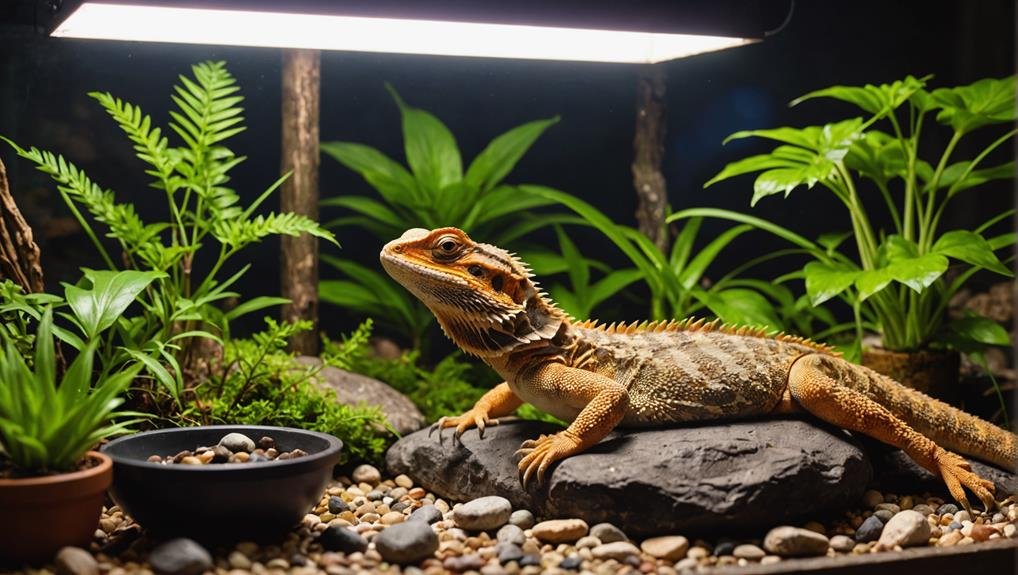When caring for a bearded dragon, you’ve got to contemplate several key aspects to guarantee they thrive. A well-thought-out habitat setup with appropriate temperature gradients and UVB lighting is essential. But that’s just the beginning—feeding them a balanced diet of insects and greens, maintaining proper hydration, and handling them gently are equally important. Regular health checks and understanding their unique behaviors, like shedding and brumation, can make a difference. Curious about how to keep your scaly friend happy and healthy? Let’s delve into each of these Bearded Dragon Care Tips and Tricks for a Healthy Pet in more detail.
Key Takeaways
- Ensure proper tank ventilation with a screened lid and maintain a temperature gradient for optimal health.
- Use a UVB bulb and heat lamp to provide necessary lighting and heat, monitoring temperatures closely.
- Balance the diet with appropriate ratios of insects and leafy greens according to the dragon’s age.
- Maintain humidity levels between 30-40% and avoid exceeding 50% to prevent respiratory problems.
- Provide enrichment through climbing structures, interactive toys, and supervised outdoor walks.
Habitat Setup
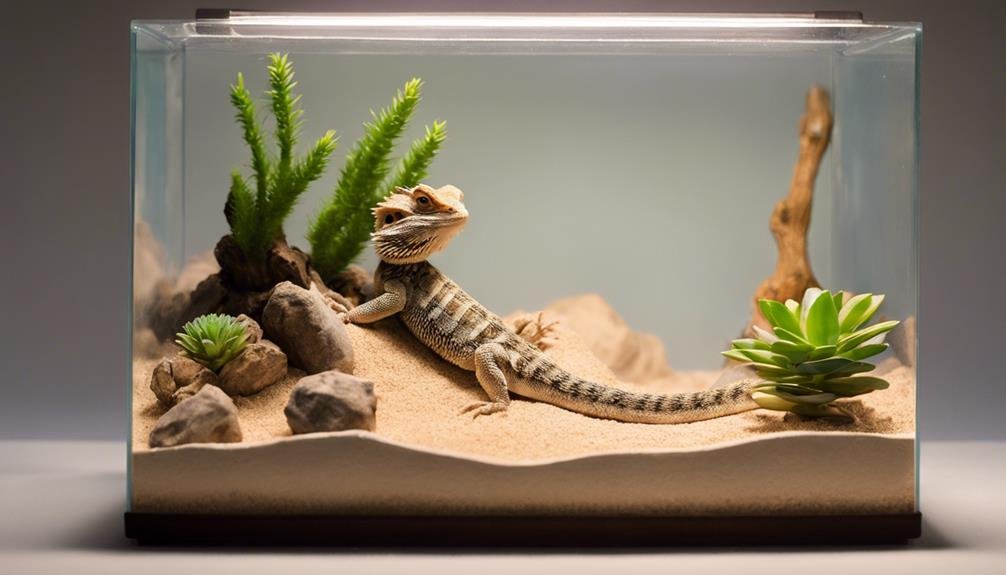

When setting up a habitat for your bearded dragon, it’s essential to ensure they’ve enough space to thrive. An adult bearded dragon needs a minimum of a 40-gallon tank, but larger is always preferable. Opt for a Bearded Dragon Tank measuring 48 x 24 inches. This site provides ample room for climbing, basking, and exploring, which are important for their physical and mental well-being.
A screened lid is necessary for proper ventilation, preventing stagnant air, and maintaining a healthy environment.
When arranging the habitat decor, aim to mimic their natural surroundings. Use rocks, branches, and hides to create a stimulating environment. These elements give your bearded dragon places to climb, explore and help them feel secure.
Establishing a temperature gradient within the tank is essential. Place basking spots at one end with cooler areas at the other. This allows your bearded dragon to regulate their body temperature by moving between the warm and cool zones.
Temperature and Lighting
Proper temperature and lighting are fundamental for the health and well-being of your bearded dragon. Establishing a temperature gradient in their vivarium would be best, with the hot end reaching 38-42 degrees Celsius and the cool end at 22-26 degrees Celsius. Use a heat lamp to achieve this gradient, placing it at one end of the vivarium. Additionally, bearded dragons require a UVB bulb, ideally a 10-12% fluorescent UV tube, to help prevent metabolic bone disease and replicate their natural habitat.
Monitoring humidity is also crucial. Keep it low and use a hygrometer to maintain levels within the best range.
Here’s a quick reference table for your setup:
| Component | Ideal Range | Tools Needed |
|---|---|---|
| Hot End Temp | 38-42°C | Heat lamp |
| Cool End Temp | 22-26°C | Thermometer |
| UVB Exposure | 10-12% Fluorescent UV Tube | UVB bulb |
| Humidity | Low | Hygrometer |
Maintaining these conditions supports your bearded dragon’s overall health and well-being. Always refer to a care booklet for detailed requirements on heat and lighting to create the finest environment for your pet.
Feeding and Nutrition
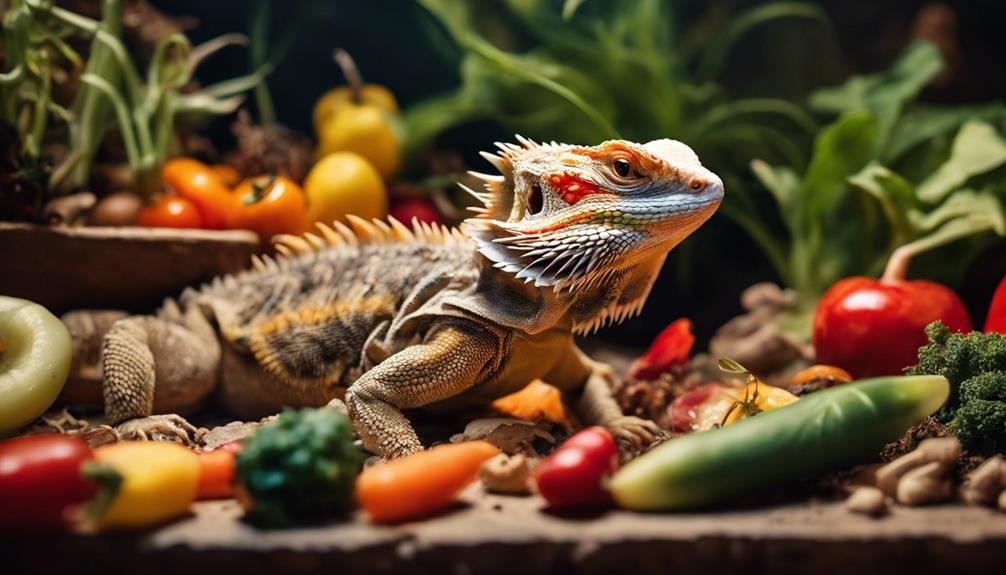

A balanced diet is essential for their health when feeding your bearded dragon.
Young dragons need mostly insects, while adults thrive on a plant-based diet.
Always dust insects with calcium and vitamins, and provide a variety of leafy greens and vegetables, along with fresh water daily.
Balanced Diet Essentials
A bearded dragon’s diet is essential to its overall health and well-being, so correcting it is crucial. Bearded dragons need UVB lighting to metabolize calcium, which is necessary for strong bones. Their diet of insects and plants must be balanced, with young dragons consuming 70% insects and 30% plants. As they mature, this ratio should shift to 50% insects and 50% plants.
Insects like crickets, mealworms, and dubia roaches are excellent protein sources. Be sure to gut-load these insects—feeding them nutritious foods before offering them to your dragon—to maximize their nutritional value.
Plants should include leafy greens like collards, mustard, and dandelion greens. Avoid lettuce, as it offers little nutritional benefit.
Supplements are crucial for your bearded dragon’s health. Calcium with vitamin D3 prevents metabolic bone disease, while a multivitamin powder ensures they get all the necessary nutrients. Sprinkle these supplements on their food a few times a week. Fresh water should always be available to keep your bearded dragon hydrated.
Safe Feeding Practices
Feeding your bearded dragon safely involves more than just providing a variety of foods; it’s about guaranteeing each meal is nutritious and free from harmful substances. Start by offering a balanced diet, including live insects like crickets, roaches, and leafy greens, to meet their omnivorous needs. Confirming the insects are gut-loaded and dusted with calcium and vitamin supplements will help your dragon get the necessary nutrients.
To keep your bearded dragon healthy, follow these key practices:
- Live Insects: Provide gut-loaded crickets or roaches dusted with calcium powder.
- Leafy Greens: Offer nutritious options like collard, mustard, and dandelion greens.
- Toxic Foods: Avoid feeding poisonous foods such as avocado, rhubarb, and iceberg lettuce.
- Hydration: Guarantee a shallow water bowl is always available, especially for younger dragons.
Monitor their dietary needs closely as they grow, adjusting the balance of protein, fats, and plant matter. Young dragons need more protein from insects, while adults benefit from more leafy greens. Regularly adapt their diet to guarantee they thrive at every stage of life.
Hydration and Humidity
Proper hydration and humidity are necessary for your bearded dragon’s overall health. Keeping hydration levels within the ideal range would guarantee your dragon stays happy and healthy. Proper hydration prevents dehydration, which can lead to severe health issues, including kidney problems and shedding difficulties. Providing a water bowl for drinking is a simple yet effective way to ensure your bearded dragon has access to water at all times.
Aim for a humidity range of 30-40% in the habitat. Monitor the humidity levels regularly using a hygrometer to avoid fluctuations. A humidity level above 50% can cause respiratory issues and skin problems, so keeping it within the recommended range is essential. Occasional misting can also help maintain proper hydration but be cautious not to overdo it.
Proper hydration and humidity are crucial for your bearded dragon’s shedding process. Inadequate hydration can result in incomplete sheds, which can cause skin infections. Maintaining the right balance of hydration and humidity ensures your bearded dragon remains in peak condition inside and out.
Handling and Interaction
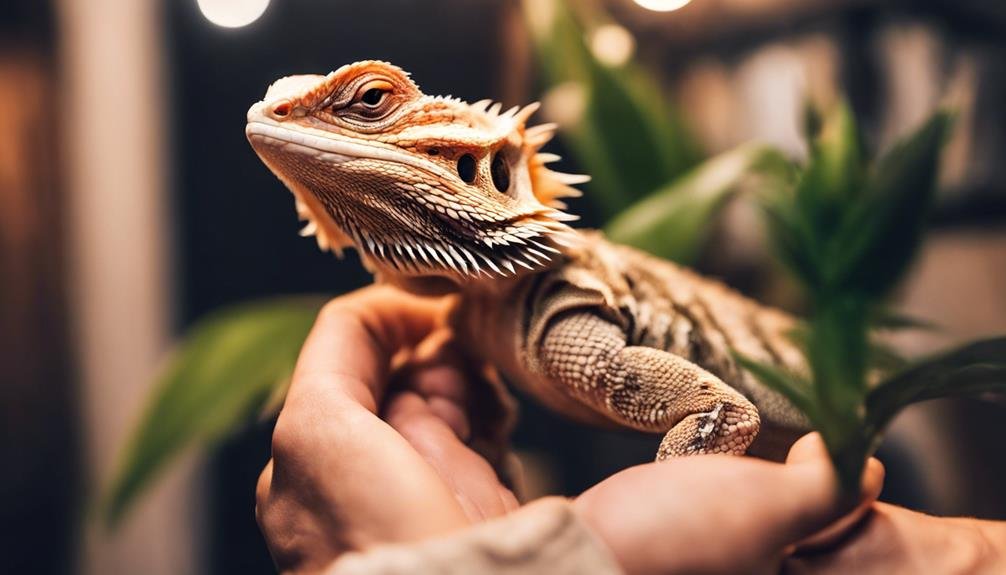

When handling your bearded dragon, always support its entire body to reduce stress and prevent injury.
Never pick it up by the tail, which can cause discomfort and harm.
Proper Handling Techniques
Proper handling techniques are crucial to safeguard your bearded dragon’s well-being and comfort. When it comes to handling, always remember to be gentle and patient. This builds trust and helps prevent aggressive behavior. Here are some essential tips to keep in mind:
- Never pick up by the tail: Bearded dragons have delicate tails that can be easily injured. Always support their body with your hand.
- Gentle interactions: Approach your bearded dragon calmly and allow it to become familiar with your scent. This encourages a positive relationship.
- Quiet environment: To minimize stress, handle your bearded dragon in a tranquil space. Loud noises can startle it and make the experience unpleasant.
- Understand natural behaviors: Recognizing signs of discomfort, such as puffing up or hissing, helps you adjust your approach. This guarantees you handle them properly and avoid causing stress.
Regular, gentle handling will help your bearded dragon get used to human interaction and feel more at ease. Understanding their natural behaviors allows you to anticipate their reactions and adjust your handling techniques accordingly. Proper handling is a cornerstone of ensuring your bearded dragon stays happy and healthy.
Reducing Stress Levels
Building on proper handling techniques, let’s focus on reducing stress levels during interactions with your bearded dragon. To reduce stress levels, handle your bearded dragon gently and avoid picking it up by its tail. Always support its body fully, using both hands if necessary. This way, it feels secure and less vital.
Creating a quiet and calm environment for handling and interaction is essential. Loud noises and sudden movements can spike bearded dragon stress levels. Find a peaceful spot in your home where you can interact with them without distractions.
Limit your handling sessions to short periods. Overhandling can overwhelm and stress your bearded dragon. Start with five to ten minutes and gradually increase the time as your dragon becomes more comfortable.
Pay close attention to your bearded dragon’s body language. Signs of stress include darkening of the beard or puffing up of spikes. If you notice these, give them a break and allow them to calm down.
Provide hiding spots and enrichment in their habitat. This will offer a sense of security and help reduce stress levels. Hiding spots allow them to retreat and feel safe, which is crucial for their well-being.
Health Monitoring
Monitoring your bearded dragon’s health is important to maintaining its well-being and longevity. Observing your dragon’s behavior, appetite, and activity levels daily is essential for preserving the Dragon’s Health. By closely monitoring these aspects, you can detect potential issues early and provide proper care.
Here’s a quick checklist to help you monitor your bearded dragon’s health effectively:
- Behavior and Activity Levels: Notice changes in your dragon’s usual behavior. A lethargic dragon might be indicating an underlying health issue.
- Appetite: A sudden decrease in appetite can suggest stress or illness. Guarantee your dragon is eating regularly and maintaining a healthy weight.
- Temperature: Regularly measure and maintain proper temperatures in the habitat. Optimum temperatures are crucial for digestion and overall health.
- Metabolic Bone Disease: Regularly check for signs such as limping or deformities. Early detection and proper care can prevent this debilitating condition.
Additionally, schedule annual vet visits to address health concerns and optimize your dragon’s overall well-being. By following these steps, you’ll be on the right path to keeping your bearded dragon healthy and thriving.
Shedding and Brumation
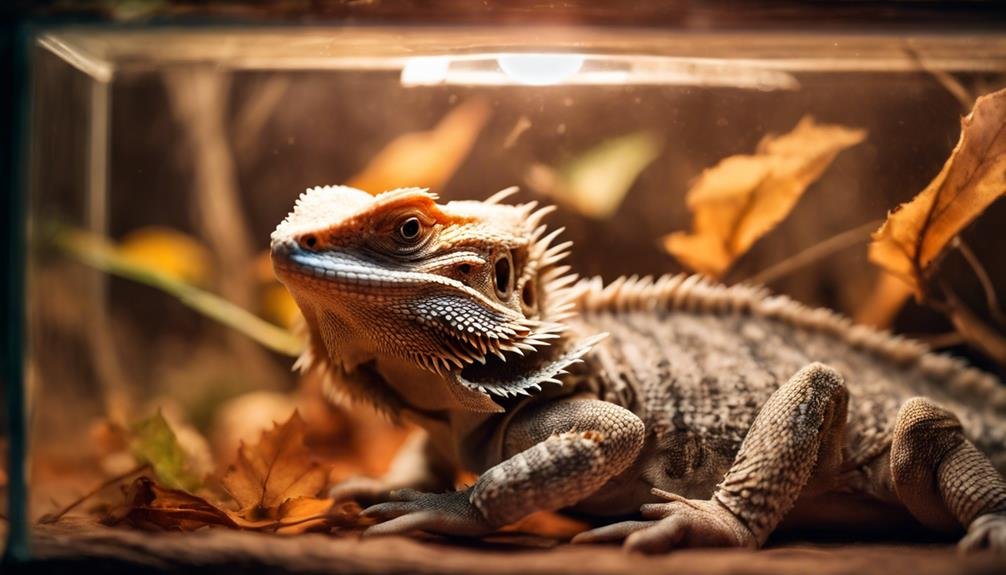

Understanding your bearded dragon’s shedding and brumation cycles is essential for its health. Bearded dragons shed their skin in large pieces as they grow, and this process requires proper humidity levels to maintain healthy shedding. Younger dragons shed more frequently, often needing extra care to facilitate the process. Make sure to uphold a comfortable environment with appropriate lighting and humidity. This helps prevent shedding problems, such as retained skin, which can cause discomfort and health issues.
Brumation is a natural process where bearded dragons become less active and may eat less during cooler seasons. It’s similar to hibernation in other animals. During brumation, your dragon might appear lazy and spend more time sleeping. This is normal, but monitoring their behavior and weight closely is important. Ensure they have a quiet, safe space to rest and reduce feeding frequency, as they won’t need as much food.
Keep an eye on both shedding and brumation cycles. See veterinary advice if you notice irregularities, such as prolonged lethargy or difficulty shedding. Understanding and managing these natural processes will help your bearded dragon stay healthy and happy.
Enrichment and Exercise
Incorporating enrichment and exercise into their routine is crucial to keeping your bearded dragon healthy and happy. Providing opportunities for physical activity and mental stimulation helps prevent boredom and promotes overall well-being. Here are some effective ways to achieve this:
- Climbing Structures: Place branches and rocks in the vivarium to encourage your bearded dragon to climb. This offers excellent exercise and mimics their natural habitat.
- Dig Box: Create a dig box with a safe substrate. This will allow your dragon to engage in natural digging, providing physical and mental enrichment.
- Outdoor Walks: Supervised outdoor walks can be a great way to stimulate your dragon’s senses and provide a change of scenery. Make sure the area is safe and escape-proof.
- Interactive Toys and Puzzles: Use interactive toys and puzzles to promote mental stimulation. These can prevent boredom and keep your dragon’s mind sharp.
Additionally, rotating and varying the placement of decorations and hides in the tank keeps your bearded dragon active and engaged. Integrating these enrichment activities into its daily routine guarantees that it stays fit, happy, and mentally stimulated.
Conclusion
You’ll guarantee your bearded dragon thrives by following these care tips and tricks. Set up a spacious habitat with proper temperature and lighting, offer a balanced diet, and check hydration and humidity levels. Handle your dragon gently, monitor its health, and understand its shedding and brumation cycles. Don’t forget to provide enrichment activities for mental and physical stimulation. Your scaly friend will be happy and healthy thanks to your dedicated care.
FAQs
1. How to Care for a Bearded Dragon for Beginners?
Start with a proper feeding schedule, balancing insects and plants. Confirm you’ve got the right heating requirements for their tank. Handle them regularly using gentle techniques to build trust and reduce stress.
2. Are Bearded Dragons Easy to Take Care Of?
Yes, bearded dragons are easy to care for. To guarantee their health and happiness, you must focus on feeding frequency, proper habitat setup with lighting and heating, and regular vet check-ups.
3. What Not to Do With a Bearded Dragon?
It would be best not to feed your bearded dragon avocado, rhubarb, or iceberg lettuce. Avoid housing multiple adults together. Don’t use sand or gravel substrates. Handle them gently, avoiding the tail. Never skip regular vet check-ups to [GUARANTEE] their well-being.
4. How Do You Keep a Bearded Dragon Happy?
To keep a bearded dragon happy, provide enrichment activities, socialization opportunities, and environmental stimulation. Create a spacious habitat with climbing areas and hiding spots. Handle them gently and regularly to build trust and guarantee their well-being.
Supportive Article
Crocodile Eyes Vs. Human Eyesight

